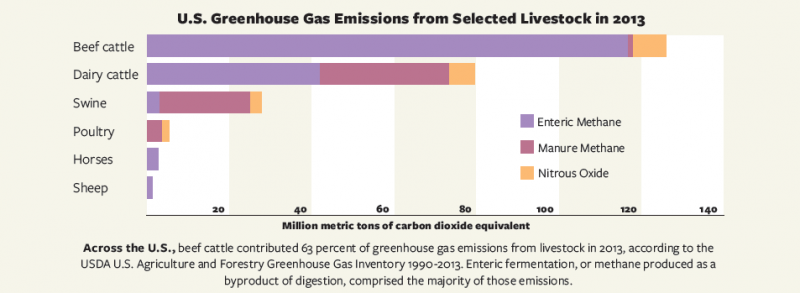Ranchers ready for a warmer future
Like most industries, livestock production contributes to climate change. In the U.S., the agricultural sector contributed 8.4 percent of total greenhouse gas emissions in 2017 according to the U.S. Environmental Protection Agency’s Draft 2019 Inventory of U.S. Greenhouse Gas Emissions and Sinks. Livestock are responsible for more than half of that, thanks in large part to the methane they release through enteric fermentation as burps and flatulence, key parts of the digestive cycle of ruminants, and waste. In 2017, methane emissions from enteric fermentation represented 26.4 percent of total methane emissions from all anthropogenic activities, making it the largest source of methane emissions in the U.S (though methane emissions only comprise 10.2 percent of all U.S. emissions). While they have an impact on emissions, livestock and producers will also be the victims of climate change, just like everyone else. A hotter climate will take a toll on vulnerable animals, ranchers, and their market.
“There’s no doubt that our droughts have become more frequent,” says Terry Fankhauser, executive vice president of the Colorado Cattlemen’s Association. “Loss in forage and loss in production create a large-scale and fundamental change to the future of agriculture in Colorado. It has been very devastating to some people, and to others it has been quite expensive.”
Cattle and sheep graze on rain-fed forage grasses on Colorado’s plains. Very little of this land is irrigated—and even if it were, the state’s irrigation water comes from diminishing mountain snowpack which was down 33 percent in spring 2018. That means when Colorado is in a drought, there’s less natural food available for livestock. To compensate, ranchers have the choice of either running fewer animals on their land, or subsidizing natural forage with hay from the market. However, both of these options affect the bottom line, making them short-term solutions, untenable in the long-term.
In a 2016 article in Colorado Water, Reagan Waskom, director of the Colorado Water Institute, predicts that warmer winter temperatures will improve the survival rates of newborn animals on the range. But in many situations that will mean less food will be available for cattle and sheep. At the same time, a warmer climate will bolster the invasion of weeds and woody plants on grazing lands, which are less tasty and more likely to create health problems for cattle, like lump jaw which arises from wounds inside the mouth and can cause animals to stop eating.
Ranchers, therefore, are planning carefully for the future. “We do see a lot of things changing in the industry,” says Fankhauser. Ranchers are making greater use of technology, investing in the genetic selection of animals able to perform at their full potential in harsher environments. To increase climate resilience, ranchers are working to keep the rangelands healthy and not overgraze says Brad Udall, a senior water and climate research scientist at the Colorado Water Institute. “It means using land efficiently when there is moisture, and staying off when there isn’t. It’s important to have stocking rates that make sense, and not try to get too much out of a piece of ground. Ranchers are smart. They know their livelihoods are dependent upon healthy rangelands.”
For consumers, the solution to reducing methane emissions is not necessarily to forego their omnivorous tendencies just yet, says Kate Greenberg, the Colorado Commissioner of Agriculture. “There is an incredible interdependence between humans, animals and the land that extends beyond methane emissions. Animals are integral to functioning ecosystems and natural cycles,” Greenberg says. “Many ranchers are experimenting with practices that increase the regenerative capacity of the land and the resilience of their operation. Eaters are a part of this work. This is a good chance to get to know your local rancher and help ensure we can keep up a secure food supply in a more uncertain future.”


 Print
Print